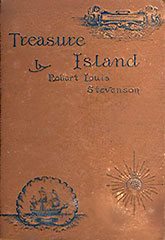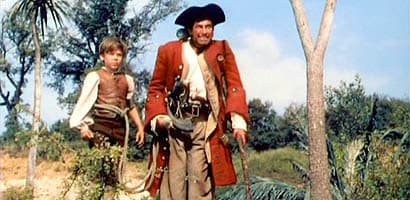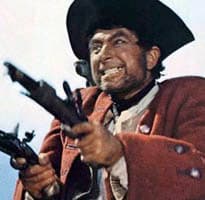Treasure Island
Critique • Quotes • Text • At the movies
 First edition
First editionOriginal title
The Sea Cook: A Story for Boys
First publication
1881–1882 in magazine Young Folks
First book publication
1883
Literature form
Novel
Genres
Literary, adventure, young adult
Writing language
English
Author's country
Scotland
Length
Approx. 67,000 words

Bobby Driscoll and Robert Newton fasten onto each other in 1950 Treasure Island.
The devil we don't know
Treasure Island (1950): Film, 96 minutes; director Byron Haskin; writer Lawrence Edward Watkin; featuring Bobby Driscoll, Robert Newton, Basil Sydney, Walter Fitzgerald
Until 1950 the Walt Disney studio had made only animated features. It may seem odd that for their first live-action film, Disney chose to make one that might be seen as glorifying a cutthroat pirate.
Even odder that they did it so well.
It may also be the first Treasure Island filmed in glorious colour. Though the 1934 movie made effective use of light and shadow, the colour in 1950 seems to open up the story, placing most of it on seemingly real high seas and on a seemingly real tropical island.
More to the point, it gave Robert Newton a fuller range for a brilliant movie performance as Long John Silver, by turns subtle and over the top, but always magnetic.
The script also deviates from the book and from the earlier version in ways that plays to Newton's characterization. Much of the story's introductory material taking place at the Admiral Benbow Inn is dispensed with—we don't even meet young Jim Hawkins's mother—to get to the race between Jim's crew and Silver's gang to find the treasure and the skulduggery that takes place on both sides. Or, I should say, on the three or four sides that develop.
Silver plays all sides and we're never quite sure how sincere his professed friendship with Jim is. He sweet-talks, he threatens, he curses. He attacks, he makes peace, he demands loyalty, he betrays everyone (except Jim, it seems). He's a complete enigma that we fear but want to know.
Newton even invents the "Arrrh!" exclamation and the exaggerated take on Britain's West Country accent that fictional pirates have adopted ever since.
Bobby Driscoll is a perfect stand-in for us. Unlike Cooper, he plays Jim as the young lad he's supposed to be, never pretentious, just a kid having a brilliant adventure. Like us he's both enchanted and appalled by Silver. When he outfoxes the pirates, we see that Long John recognizes a fledgling fellow conniver, like a better version of himself.
Perhaps this is reading, or seeing rather, too much into this. But the point is that the Hawkins-Silver relationship is never cloying or hackneyed.
At the end, as Silver goes off—having gotten away with Jim's help in a manner not seen before, but which puts them on an equal footing—we're still wondering what's really going on in that pirate's heart. We still don't trust him, but we don't condemn him either. Which seems about right.
Some, raised on the sea battles of classic pirate flicks or the CGI-effects of the more recent Pirates of the Caribbean franchise, may consider this movie boring. But Treasure Island isn't meant to be that sort of thriller. It's a family film with a surprising ambivalence at the heart of it, centered on the character of Long John Silver encountered by an impressionable yet cool-headed young person. In certain ways it's a coming-of-age film, as Jim moves from the verities with which he was raised to the greater challenges of life in which things—and people—aren't always what they seem.
At the end, we want to see more. We certainly want to see more of Silver. And we sort of get our wish.
— Eric


